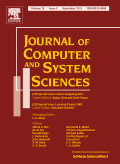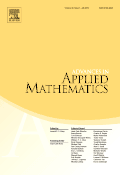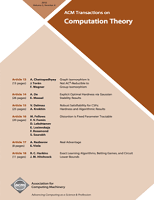
Annales Mathematicae et Informaticae
Scope & Guideline
Unveiling innovative insights in mathematical and computational realms.
Introduction
Aims and Scopes
- Mathematical Theory and Applications:
The journal publishes research that explores foundational mathematical theories, as well as their applications in various fields such as physics, computer science, and engineering. - Computational Methods and Algorithms:
A significant focus is placed on the development and analysis of algorithms, particularly in the context of data science, machine learning, and optimization techniques. - Interdisciplinary Research:
The journal encourages interdisciplinary studies that integrate mathematics with other domains such as education technology, health informatics, and environmental science. - Educational Challenges in Mathematics and Computing:
Research addressing pedagogical approaches and challenges in teaching mathematics and computing is a consistent theme, reflecting the journal's engagement with educational methodologies. - Graph Theory and Combinatorics:
The exploration of graph theory, combinatorial structures, and their applications in network analysis is a recurring area of interest.
Trending and Emerging
- Artificial Intelligence and Machine Learning:
There is a noticeable increase in research related to AI and machine learning, specifically in applications such as natural language processing and computer vision, indicating a strong trend towards integrating mathematics with advanced computational techniques. - Blockchain and Cryptography:
Emerging themes around blockchain technology and cryptographic techniques are gaining attention, reflecting the growing relevance of secure digital transactions and data integrity in the modern world. - Health Informatics and eHealth Solutions:
Research on health informatics, particularly in the context of pandemic responses and smart health monitoring systems, has become increasingly prominent, showcasing the journal's engagement with real-world applications. - Educational Technology in Mathematics:
The integration of technology in mathematics education, including studies on the use of programming and machine learning in teaching, reflects a growing interest in enhancing educational methodologies. - Quantum Computing Applications:
With the rise of quantum computing, there is a trend towards exploring its applications in various fields, indicating an emerging area of research that combines mathematics with cutting-edge technology.
Declining or Waning
- Traditional Algebraic Structures:
Research on classical algebraic structures, such as group theory and ring theory, appears less frequently, possibly due to the growing interest in computational approaches and applications. - Basic Statistical Methods:
Papers focusing on traditional statistical methods are becoming less common, as newer methodologies in data science and machine learning gain prominence. - Elementary Number Theory:
While still relevant, publications in elementary number theory have decreased, possibly as researchers shift towards more complex applications and computational techniques.
Similar Journals

JOURNAL OF COMPUTER AND SYSTEM SCIENCES
Unveiling groundbreaking discoveries in computing and systems.The Journal of Computer and System Sciences is a distinguished publication founded in 1967 and continually striving to push the boundaries of knowledge in computer science and applied mathematics. Published by Academic Press Inc, Elsevier Science, this journal boasts impressive credentials, holding a Q1 quartile ranking across multiple categories including Applied Mathematics, Computational Theory and Mathematics, Computer Networks and Communications, and Theoretical Computer Science as of 2023. With a focus on innovative research and comprehensive theoretical developments, this journal serves as a pivotal forum for authors and readers alike, facilitating cutting-edge contributions to the field. The journal is not currently open access, providing a curated selection of high-quality articles for its subscription residents. By engaging with this journal, researchers, professionals, and students can gain insight into the latest trends, prominent methodologies, and significant findings that shape the modern landscape of computing and systems analysis.

DISCRETE MATHEMATICS AND THEORETICAL COMPUTER SCIENCE
Advancing Knowledge at the Intersection of Mathematics and ComputingDISCRETE MATHEMATICS AND THEORETICAL COMPUTER SCIENCE, published by DISCRETE MATHEMATICS THEORETICAL COMPUTER SCIENCE in France, stands as a significant open-access journal since 1997, publishing innovative research articles within the intersecting disciplines of discrete mathematics and theoretical computer science. With an ISSN of 1462-7264 and an E-ISSN of 1365-8050, this journal aims to provide a platform for scholarly discourse and dissemination of knowledge, making it accessible to a global audience. It is recognized for its contributions, achieving a Q2 ranking in both Computer Science (Miscellaneous) and Discrete Mathematics and Combinatorics, alongside a Q3 ranking in Theoretical Computer Science as of 2023. The journal’s rigorous selection process ensures that only high-quality research is published, promoting advancements in these critical areas of study. Researchers, professionals, and students alike can benefit from its comprehensive articles that not only enhance theoretical understanding but also foster practical applications in the ever-evolving landscape of computer science.

Acta Universitatis Sapientiae-Mathematica
Connecting researchers to the forefront of mathematical innovation.Acta Universitatis Sapientiae-Mathematica is a dynamic and open-access academic journal published by SCIENDO, dedicated to advancing research in the field of mathematics. With its roots grounded in Germany, the journal has made significant strides in promoting scholarly contributions since it became open access in 2013, enhancing accessibility for researchers, professionals, and students alike. Spanning a broad spectrum of mathematical disciplines, including general mathematics, the journal engages with contemporary challenges and offers a platform to explore innovative approaches. Although currently positioned in the Q4 quartile for 2023 within the miscellaneous mathematics category and holding a Scopus rank of #290 out of 399, the journal is committed to fostering intellectual discourse and enhancing the overall quality of mathematics research. The convergence of research presented since 2014 showcases a journey toward improvement and expanding its influence in the mathematical community. Contribute to the vibrant dialogue in mathematics by exploring the latest findings in Acta Universitatis Sapientiae-Mathematica as it continues to evolve in the academic landscape.

ADVANCES IN APPLIED MATHEMATICS
Bridging Theory and Practice in Applied MathematicsADVANCES IN APPLIED MATHEMATICS, published by ACADEMIC PRESS INC ELSEVIER SCIENCE, is a prestigious journal that has served the mathematical community since 1980. With its ISSN 0196-8858 and E-ISSN 1090-2074, the journal is based in the United States, specifically in San Diego, CA. As a leading periodical in the field, it holds a notable Q2 ranking in Applied Mathematics and has been consistently ranked in the 43rd percentile among similar journals, illustrating its relevance and impact within the discipline. Although not an Open Access journal, ADVANCES IN APPLIED MATHEMATICS plays a crucial role in disseminating significant research findings, theoretical studies, and innovative applications of mathematics that address real-world problems. Researchers, professionals, and students alike will find valuable insights in its carefully curated publications, making it an essential resource for those looking to advance their understanding and application of mathematics.

RAIRO-THEORETICAL INFORMATICS AND APPLICATIONS
Illuminating Pathways in Theoretical Informatics.RAIRO - Theoretical Informatics and Applications is a renowned academic journal published by EDP Sciences S A that has been at the forefront of disseminating innovative research and applications in the fields of computer science and mathematics since its inception in 1995. With a focus on theoretical and applied aspects of informatics, the journal serves as a vital resource for researchers and professionals seeking to explore the intricacies of computational theories and their practical applications. Although currently lacking an Open Access model, it provides invaluable insights from distinguished researchers within its Q4 category rankings across its pertinent fields. As reflected in its Scopus rankings, including a position in the 24th percentile for General Mathematics and the 9th percentile for Computer Science Applications, RAIRO is pivotal in contributing to the ongoing discourse and advancements in theoretical informatics. Researchers, professionals, and students will find this journal critical in understanding emerging trends and challenges in the rapidly evolving domains of computer science and mathematics.

Communications in Mathematics and Statistics
Innovative Insights for a Mathematical TomorrowCommunications in Mathematics and Statistics, published by Springer Heidelberg, is a prominent journal dedicated to advancing research in the fields of applied mathematics, computational mathematics, and statistics. With an ISSN of 2194-6701 and an E-ISSN of 2194-671X, the journal has established itself as a vital platform for interdisciplinary scholarly communication since its inception in 2013. The journal falls within the third quartile in various rankings including applied mathematics, computational mathematics, and statistics and probability, indicating its solid position in the global research landscape. With a focus on innovative methodologies and practical applications, Communications in Mathematics and Statistics aims to bridge the gap between theoretical research and practical implementation. Researchers, professionals, and students alike will find valuable insights and cutting-edge studies that contribute to the evolution of mathematical sciences. The journal is based in Germany, with a commitment to fostering international collaboration and accessibility in mathematical research.

ACM Transactions on Computation Theory
Driving Innovation in Computational Theory and Mathematics.ACM Transactions on Computation Theory, published by the Association for Computing Machinery, is a prestigious journal dedicated to advancing the field of computation theory and theoretical computer science. With an ISSN of 1942-3454 and an E-ISSN of 1942-3462, this journal serves as a vital resource for researchers and professionals seeking to explore groundbreaking developments in computational models, algorithms, and their mathematical foundations. The journal's rigorous standards have earned it a significant position within the academic community, as evidenced by its 2023 category quartiles, ranking in the Q1 category for Computational Theory and Mathematics and Q2 for Theoretical Computer Science. Although it operates through traditional subscription access, it maintains a critical role in disseminating cutting-edge research and fostering collaboration among experts in the United States and beyond. As an influential platform, ACM Transactions on Computation Theory is committed to contributing to the ongoing dialogue and advancement of computation theory, making it essential reading for anyone passionate about this dynamic field.

EURO Journal on Computational Optimization
Catalyzing Breakthroughs in Computational OptimizationEURO Journal on Computational Optimization, published by ELSEVIER, is a leading open-access journal that has been advancing the field of computational optimization since its inception in 2013. Catering to a diverse audience of researchers, professionals, and students, this journal addresses critical developments in computational mathematics, control and optimization, and management science. With an impressive Q1 category ranking in multiple areas, including Computational Mathematics and Management Science and Operations Research, the journal serves as a pivotal platform for disseminating groundbreaking research and innovative methodologies. Its commitment to open access ensures that valuable insights are readily available to the global academic community. With a continuous publication timeline through 2024, the EURO Journal on Computational Optimization is positioned at the forefront of its field, fostering collaboration and innovation in optimization techniques and applications.

MATCH-COMMUNICATIONS IN MATHEMATICAL AND IN COMPUTER CHEMISTRY
Bridging Theory and Application in ChemistryMATCH-COMMUNICATIONS IN MATHEMATICAL AND IN COMPUTER CHEMISTRY, published by the University of Kragujevac, Faculty of Science, stands at the intersection of mathematical theories and computational applications within the field of chemistry. This esteemed journal, recognized for its contributions to applied mathematics and miscellaneous chemistry, boasts impressive Scopus rankings, being placed in the Q1 quartile for both applied mathematics and miscellaneous chemistry, as well as achieving significant rankings in computational theory and computer science applications. With an enduring history since 1990 and continuing through 2025, MATCH not only serves as a pivotal platform for scholarly communication but also aims to bridge the gap between theoretical research and practical application. This journal is essential for researchers, professionals, and students seeking to push the boundaries of knowledge in these dynamic fields.

Mathematical Foundations of Computing
Innovating the Future through Mathematical FoundationsMathematical Foundations of Computing, published by the American Institute of Mathematical Sciences (AIMS), is a distinguished open-access journal that has been actively disseminating influential research in the fields of Artificial Intelligence, Computational Mathematics, Computational Theory and Mathematics, and Theoretical Computer Science since its inception in 2009. With its E-ISSN 2577-8838, this journal is committed to providing researchers and practitioners with cutting-edge mathematical theories and methodologies that underpin modern computational practices, which is critical for advancing the field. The journal proudly holds a Q3 categorization in several relevant domains as of 2023, reflecting its contribution and accessibility amid an evolving academic landscape. By offering open access to its content, it ensures that vital research is freely available to a global audience, enhancing collaboration and innovation. Positioned in the heart of the United States, Mathematical Foundations of Computing serves as a crucial resource for advancing knowledge and fostering discussions among researchers, professionals, and students passionate about the mathematical underpinnings of computing.